Search Result
Results for "
sepsis
" in MedChemExpress (MCE) Product Catalog:
1
Biochemical Assay Reagents
1
Isotope-Labeled Compounds
| Cat. No. |
Product Name |
Target |
Research Areas |
Chemical Structure |
-
- HY-146292
-
|
|
Epigenetic Reader Domain
|
Infection
|
|
BET-IN-8 (Compound 27) is a potent inhibitor of BET with a Ki and Kd of 0.83 and 0.571 μM, respectively. BET-IN-8 ameliorates LPS-induced sepsis in vivo. BET-IN-8 has the potential for the research of sepsis .
|
-
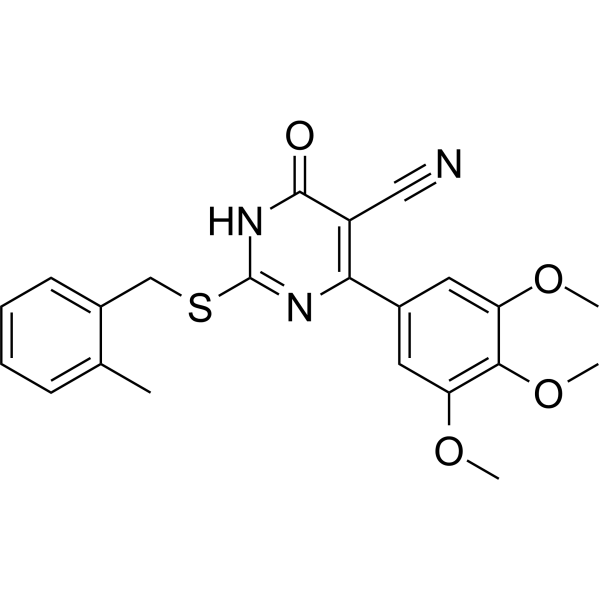
-
- HY-P99753
-
|
BAYX1351
|
TNF Receptor
|
Infection
|
|
Nerelimomab (BAYX1351) is an anti-TNF-α antibody. Nerelimomab can be used for research of sepsis .
|
-

-
- HY-162120
-
|
|
Epoxide Hydrolase
|
Infection
|
|
FZQ-21 (Compound 70P) is a soluble epoxide hydrolase (sEH) inhibitor, with an IC50 of 4 nM. FZQ-21 exhibits equal IC50 (1.5 nM) on inhibiting human sEH as EC5026 (HY-135653) (1.7 nM). FZQ-21 can be used for research of sepsis .
|
-
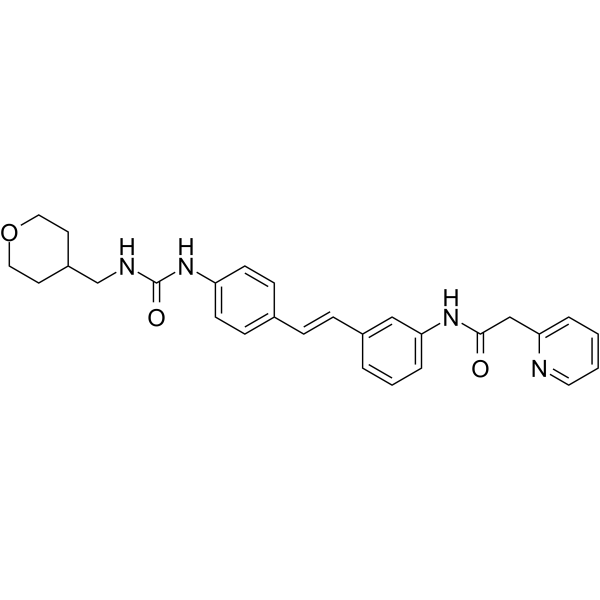
-
- HY-146291
-
|
|
Epigenetic Reader Domain
|
Infection
|
|
BET-IN-7 (Compound 1) is a potent inhibitor of BET with a Ki and Kd of 12.27 and 89.3 μM, respectively. BET-IN-7 has the potential for the research of sepsis .
|
-
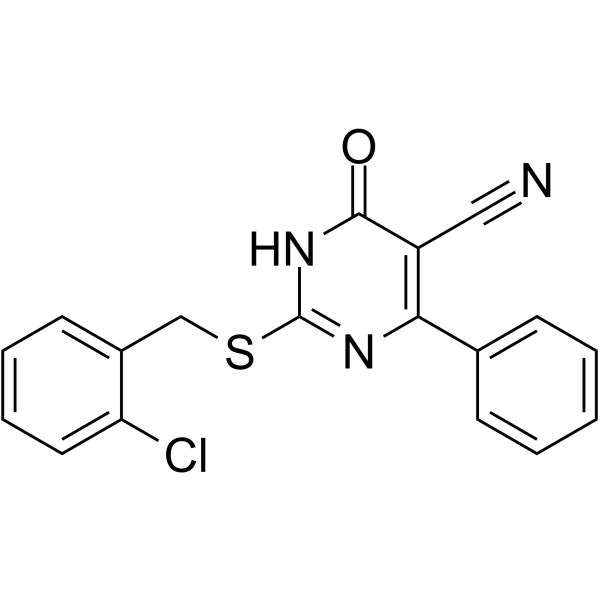
-
- HY-162260
-
|
|
MNK
|
Cancer
|
|
MNK-IN-4 (compound D25) is a potent and selective MNK inhibitor for the treatment of sepsis-related acute splenic injury .
|
-
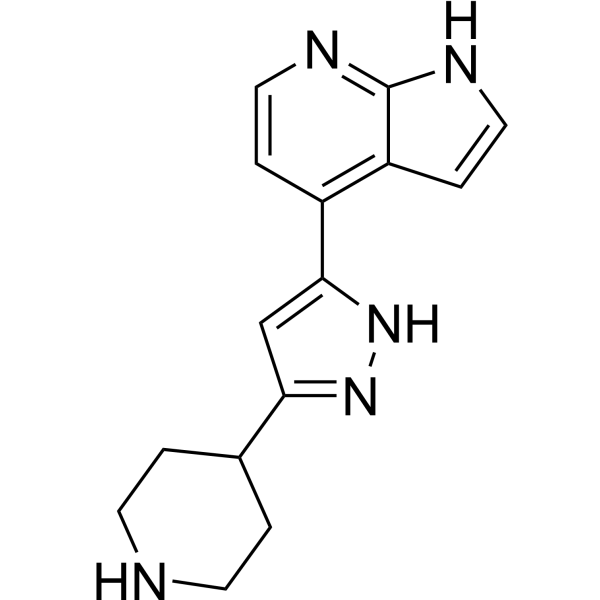
-
- HY-115977
-
|
|
Aldose Reductase
|
Inflammation/Immunology
|
|
Aldose reductase-IN-3 (Compound 5) is a potent and moderately selective inhibitor of aldose reductase (AR) with an IC50 of 3.99 μM. Aldose reductase has recently emerged as a molecular target that is involved in various inflammatory diseases, including sepsis. Aldose reductase-IN-3 has the potential for the research of sepsis .
|
-
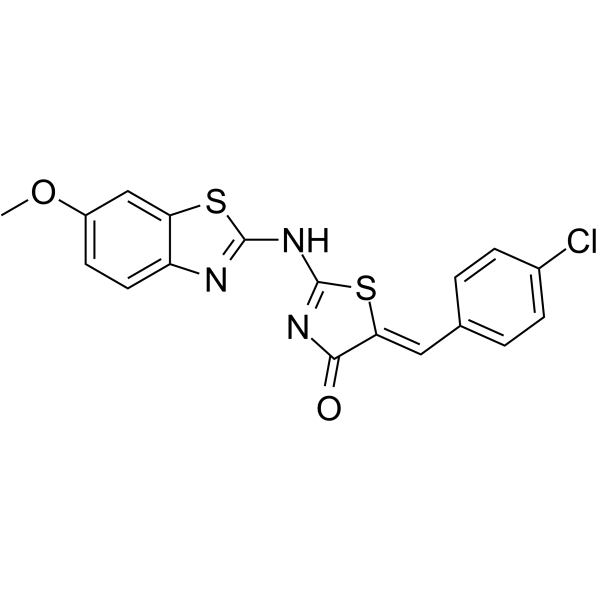
-
- HY-151970
-
|
|
STING
|
Inflammation/Immunology
|
|
STING-IN-4 (Compound 1) is a STING inhibitor that inhibits STING expression and hence reducing activation of STING and nuclear factor-κB (NF-κB) signaling. STING-IN-4 shows anti-inflammatory activity and can be used for the research of sepsis .
|
-
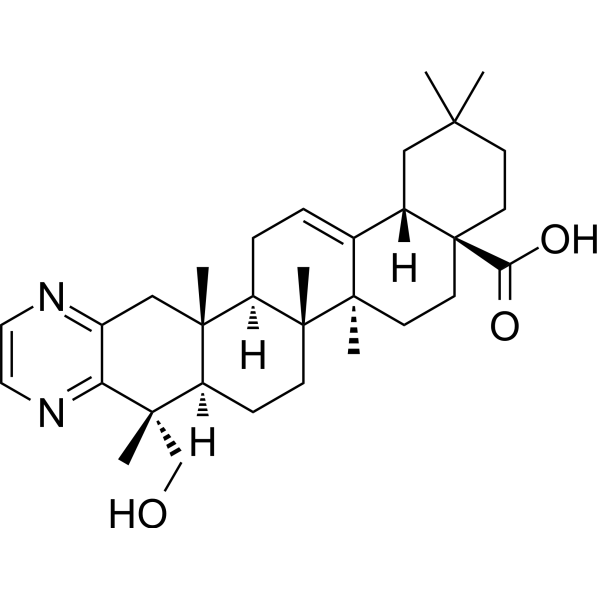
-
- HY-P5949
-
|
|
Bacterial
|
Infection
|
|
AMPR-22 is an antimicrobial peptide. AMPR-22 can bind to the bacterial membrane and induces membrane permeabilization. AMPR-22 is effective against murine model of sepsis induced by MDR strains
|
-

-
- HY-103017
-
|
|
IRAK
|
Infection
|
|
JH-X-119-01 hydrochloride is a potent and selective interleukin-1 receptor-associated kinases 1 (IRAK1) inhibitor. JH-X-119-01 hydrochloride ameliorates LPS-induced sepsis in mice .
|
-
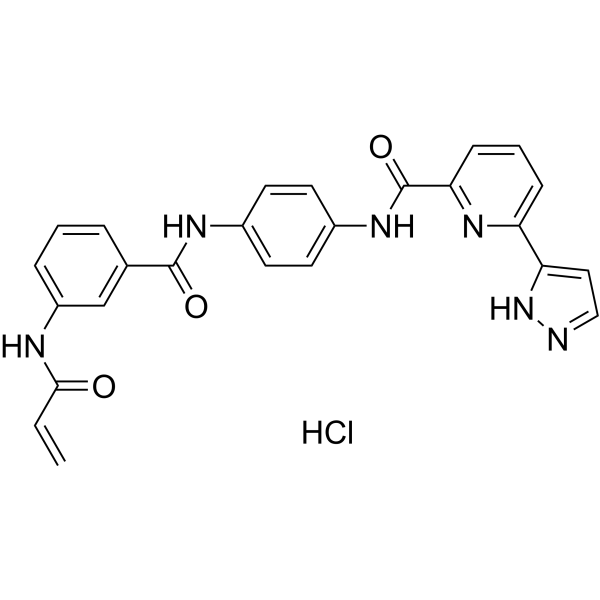
-
- HY-P10208A
-
-
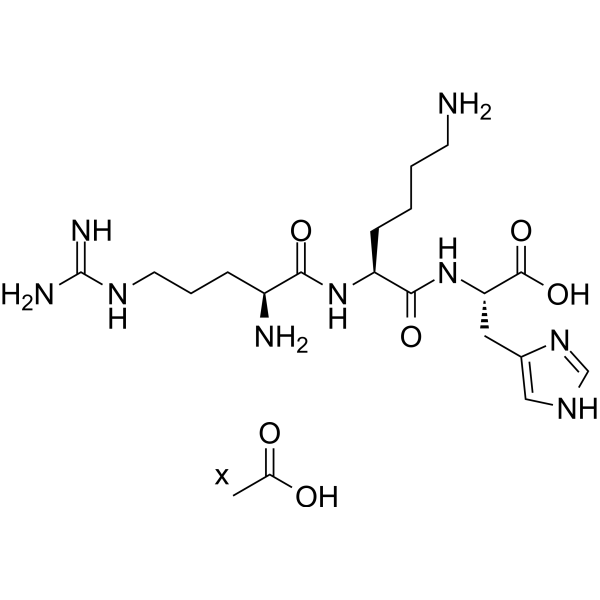
-
- HY-P10208
-
|
|
Toll-like Receptor (TLR)
|
Infection
|
|
PKH is a TLR4 antagonist. PKH is a novel tripeptide and can be isolated from Akkermansia muciniphila. RKH reduces sepsis-induced inflammatory cell activation and proinflammatory factor overproduction .
|
-
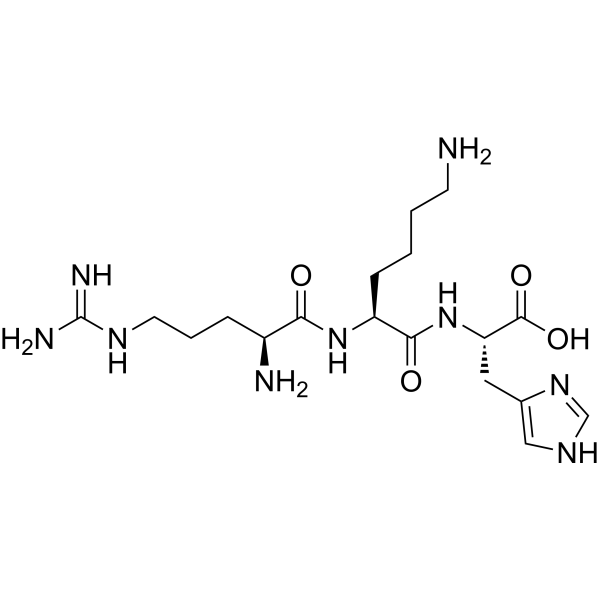
-
- HY-161059
-
|
|
RIP kinase
|
Infection
|
|
ZB-R-55 is an orally active RIPK1 inhibitor. ZB-R-55 can be used for sepsis study .
|
-
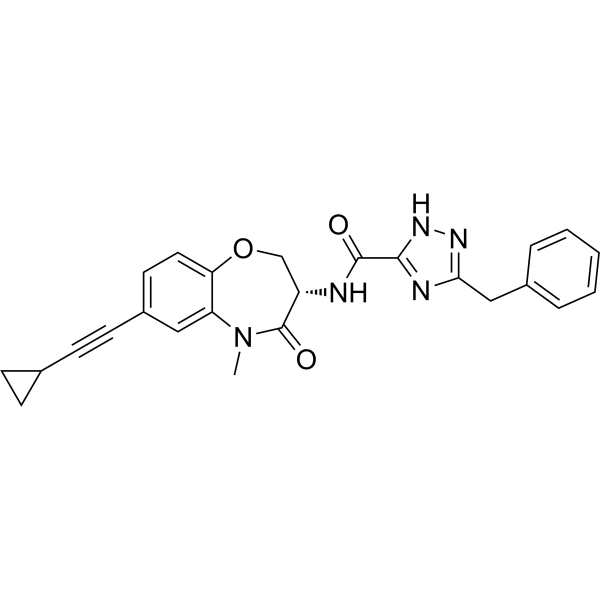
-
- HY-P99425
-
-

-
- HY-152034
-
|
|
STING
|
Inflammation/Immunology
|
|
STING-IN-5 is a potent STING inhibitor, inhibiting LPS-induced NO synthesis in macrophages with an IC50 value of 1.15 μM. STING-IN-5 inhibits the inflammatory response. STING-IN-5 can be used to research anti-inflammatory diseases and sepsis .
|
-
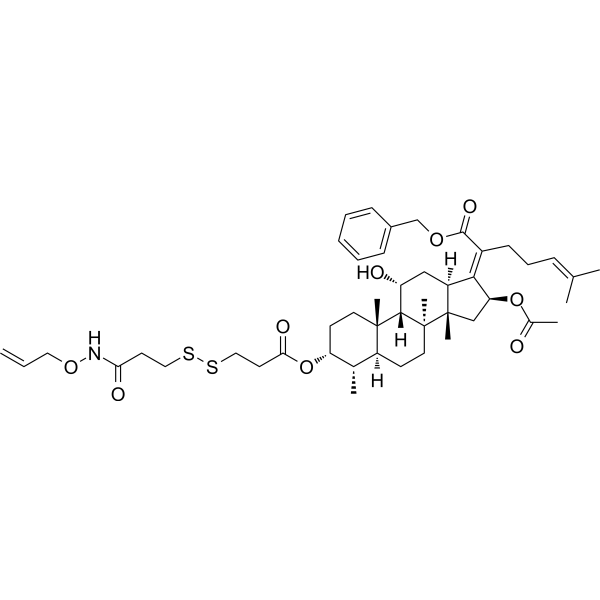
-
- HY-12124
-
|
|
NO Synthase
|
Cardiovascular Disease
|
|
BBS-4 is a potent and selective inducible nitric oxide synthase (NOS2) dimerization inhibitor, with an IC50 of 0.49 nM. BBS-4 can protect mice from the cardiovascular dysfunction of sepsis .
|
-
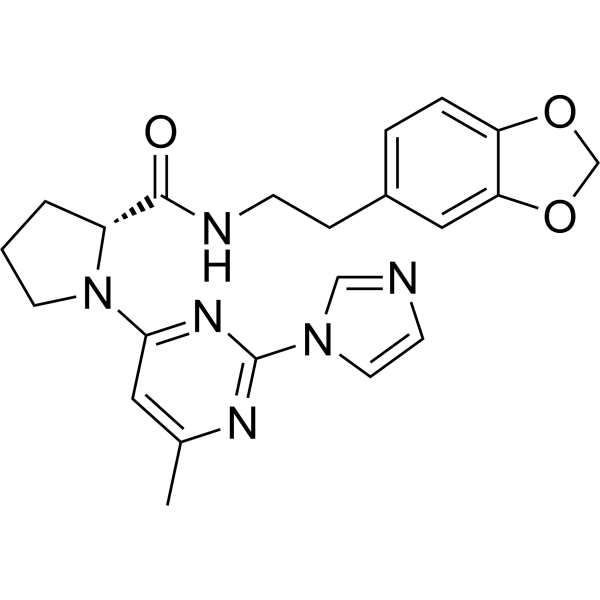
-
- HY-145996
-
|
|
Bacterial
|
Infection
|
|
STC314 is a small polyanion that interact electrostatically with histones. STC314 blocks disruption of lipid-bilayers by histones that inhibits the cytotoxic, platelet-activating and erythrocyte-damaging effects of histones. STC314 has anti-infective effects and can be uesd for sepsis research .
|
-
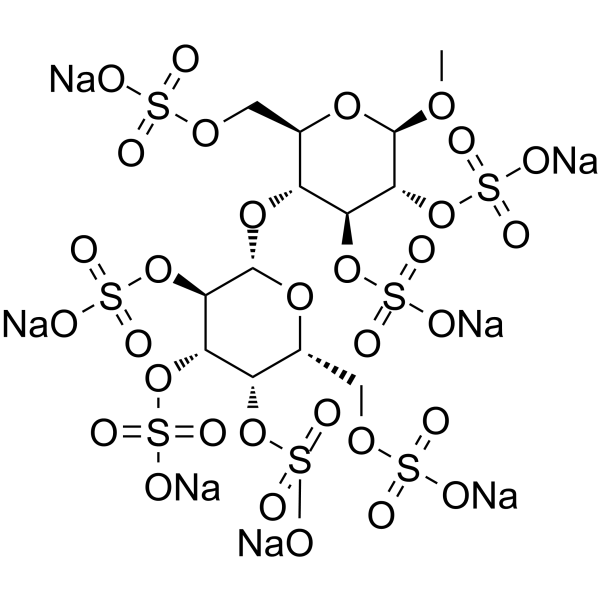
-
- HY-103639
-
|
|
Toll-like Receptor (TLR)
|
Inflammation/Immunology
|
|
M62812 (free base) is a toll-like receptor 4 (TLR4) signal transduction inhibitor. M62812 can suppress endothelial cell and leukocyte activation and prevents lethal septic shock in mice. M62812 can be used for the research of sepsis .
|
-

-
- HY-P3031
-
|
MAPK1
|
p38 MAPK
NF-κB
|
Inflammation/Immunology
|
|
Mitogen-activated protein kinase 1 (MAPK1) can activate the downstream p38/NF-κB pathway. Mitogen-activated protein kinase 1 can regulate cellular processes in various sepsis-associated diseases. MAPK-catalyzed phosphorylation of substrate proteins functions as a switch to turn on or off the activity of the substrate protein .
|
-
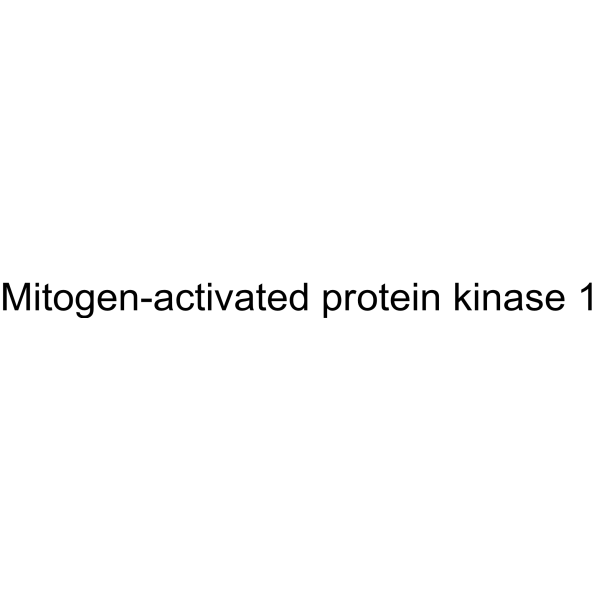
-
- HY-103639A
-
|
|
Toll-like Receptor (TLR)
|
Infection
|
|
M62812 is a toll-like receptor 4 (TLR4) signaling inhibitor. M62812 inhibits endothelial and leukocyte activation and prevents lethal septic shock in mice. M62812 can reduces LPS-induced coagulation and inflammatory responses. M62812 can be used for the research of sepsis .
|
-
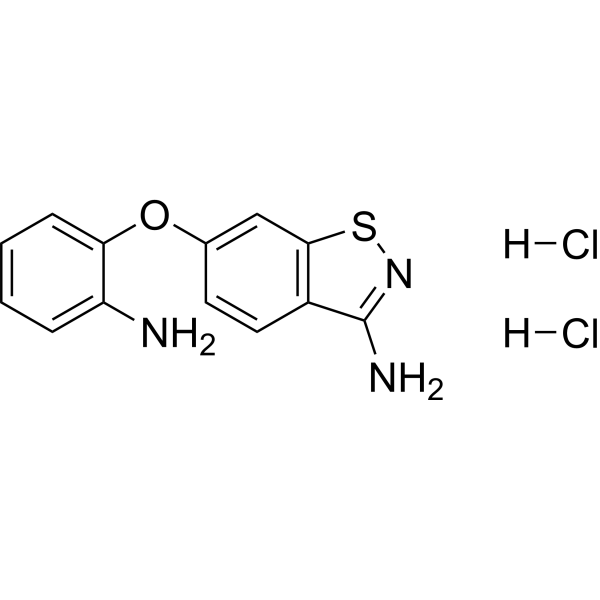
-
- HY-156367
-
|
|
RIP kinase
|
Inflammation/Immunology
|
|
RIPK1-IN-16 is an orally active and potent inhibitor of RIPK1. RIPK1-IN-16 inhibits excessive inflammation by blocking RIPK1-mediated necroptosis in vivo. RIPK1-IN-16 protects mouse from TNF-induced systemic inflammatory response syndrome and sepsis .
|
-
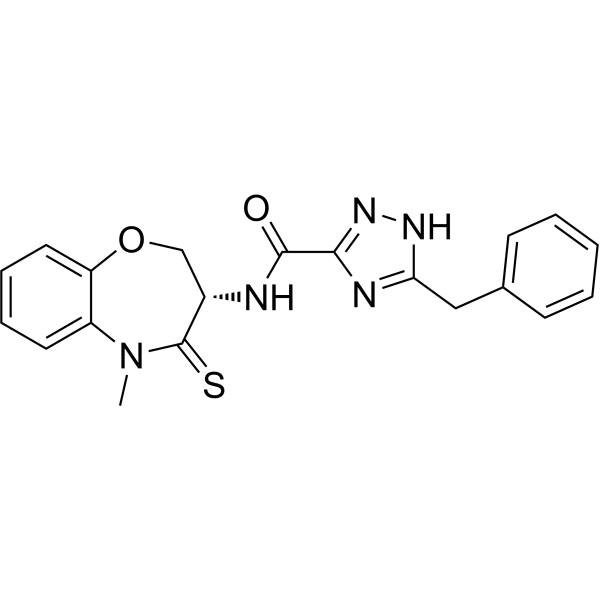
-
- HY-P99520
-
|
CaCP-29, IFX-1
|
Complement System
SARS-CoV
|
Infection
Inflammation/Immunology
|
|
Vilobelimab (CaCP-29, IFX-1) is a monoclonal anti-C5a antibody to the allergen C5a, a pro-inflammatory complement division product that plays a central role in mediating organ dysfunction. Vilobelimab acts as a C5a inhibitor, inhibiting neutrophil activation, chemotaxis, and reducing inflammatory signalling, and may be used in studies related to sepsis, COVID-19, etc .
|
-

-
- HY-102065
-
|
|
Prostaglandin Receptor
|
Others
|
|
SC-19220 is a competitive prostaglandinn E2 receptor antagonist. SC-19220 increases the bladder capacity and reduced the voiding efficiency of micturition (elicited by slow transvesical filling) of urethane-anesthetized rats. SC-19220 can restores the balance in bone marrow granulocyte and monocyte production after burn sepsis .
|
-
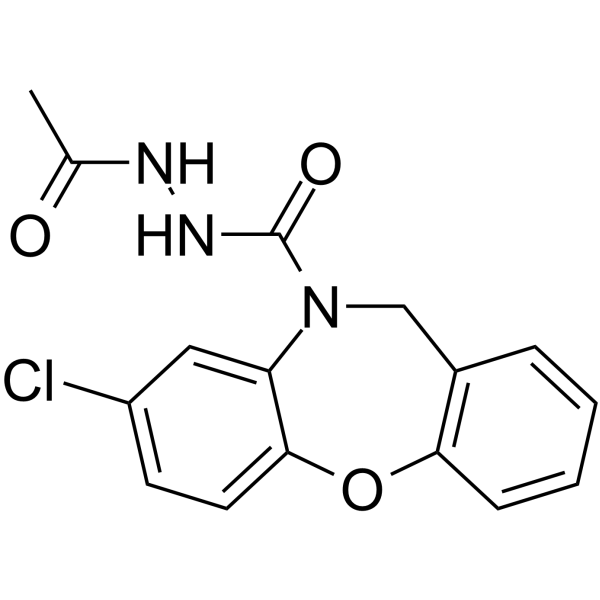
-
- HY-P2682
-
|
|
MMP
|
Metabolic Disease
|
|
MMP-8/MMP-26 Fluorogenic substrate (DNP-Pro-Leu-Ala-Tyr-Trp-Ala-Arg) is a matrix metalloproteinase-8 (MMP-8) fluorogenic substrate. MMP-8/MMP-26 Fluorogenic substrate can be used for the research of atherosclerosis, pulmonary fibrosis, and sepsis .
|
-
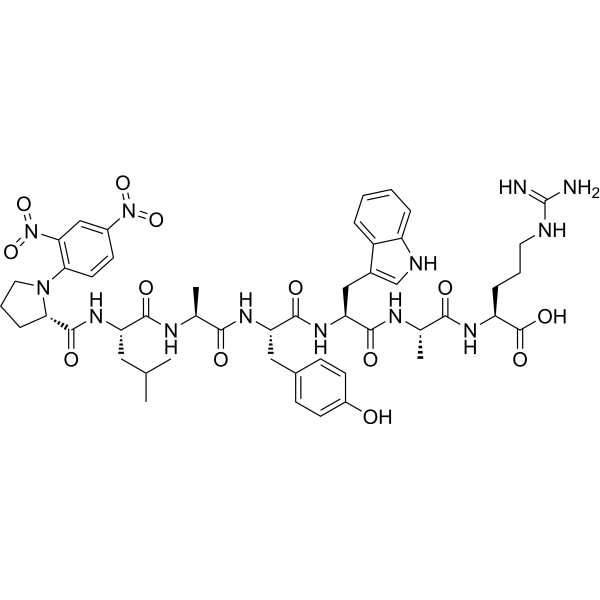
-
- HY-149485
-
|
|
JNK
|
Inflammation/Immunology
|
|
JNK2-IN-1 (Compound J27) is a JNK2 inhibitor (Kds: 79.2 μM). JNK2-IN-1 has anti-inflammatory activity. JNK2-IN-1 decreases the release of TNF-α and IL-6 through inhibiting the activation of NF-κB/MAPK pathway. JNK2-IN-1 alleviates the symptoms of LPS-induced acute lung injury (ALI) and sepsis .
|
-
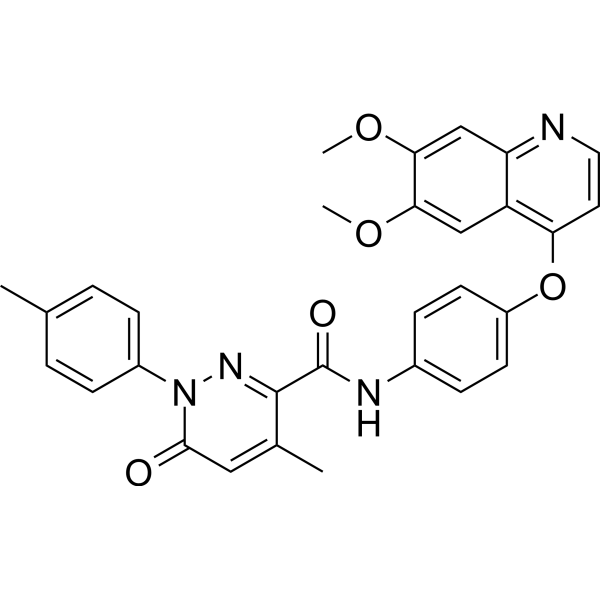
-
- HY-P2458
-
|
|
Bacterial
|
Infection
|
|
CAP18 (rabbit) is a 37 amino acids antimicrobial peptide originally isolated from rabbit granulocytes. CAP18 (rabbit) has broad antimicrobial activity against both Gram-positive (IC50, 130-200 nM) and Gram-negative (IC50, 20-100 nM) bacteria. CAP18 (rabbit) has the potential for bacterial sepsis research .
|
-

-
- HY-P3612
-
|
|
CXCR
|
Inflammation/Immunology
|
|
CTCE-0214 is a chemokine CXC receptor 4 (CXCR4) agonist, SDF-1α (stromal cell-derived factor-1α) peptide analog. CTCE-0214 shows anti-inflammatory activity, and can be used in inflammation sepsis and systemic inflammatory syndromes research .
|
-

-
- HY-163478
-
|
|
NF-κB
|
Inflammation/Immunology
|
|
TNIK-IN-9 (Compound 54) is a selective and potent NIK inhibitor, with an IC50 of 1.27 nM. TNIK-IN-9 can inhibit pro-inflammatory cytokines and nitric oxide production. TNIK-IN-9 exhibits significant anti-inflammatory effects, improved mortality, and hepatoprotective effects in sepsis models .
|
-
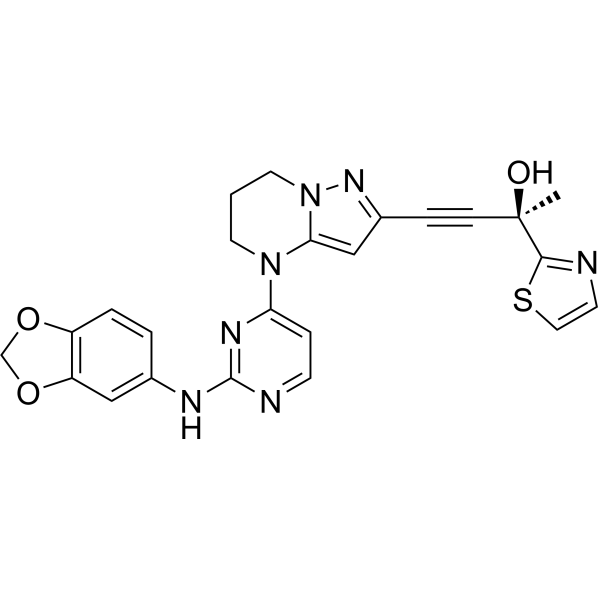
-
- HY-N6018
-
|
|
Caspase
TNF Receptor
SOD
Reactive Oxygen Species
|
Inflammation/Immunology
Cancer
|
|
Beta-Eudesmol has anticancer and anti-inflammatory activities. Beta-Eudesmol can induce apoptosis. Beta-Eudesmol is a neostigmine antagonist. Beta-Eudesmol can antagonize neostigmine-induced neuromuscular failure. Beta-Eudesmol can be used in the study of sepsis diseases. Beta-Eudesmol is a sesquiterpene-like compound that can be extracted from the rhizome of Atractylodes lancea .
|
-
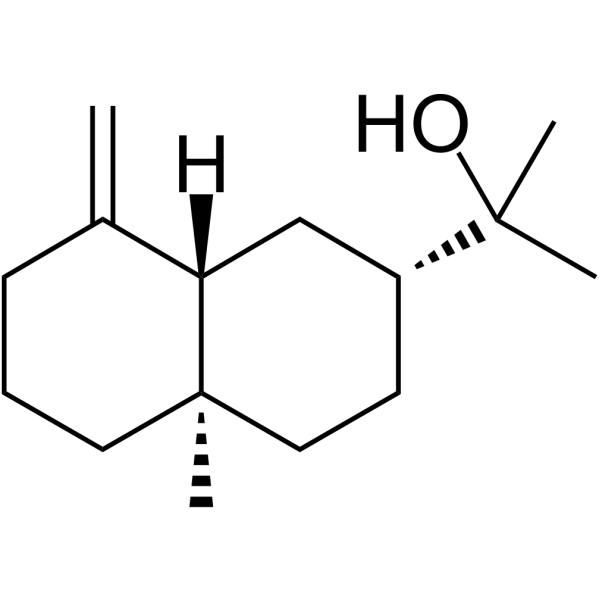
-
- HY-161072
-
|
|
NOD-like Receptor (NLR)
|
Inflammation/Immunology
|
|
CSC-6 is a NLRP3 inhibitor. CSC-6 can significantly inhibit IL-1β secreted by PMATHP-1 cells with an IC50 value of 2.3 μM. CSC-6 specifically binds NLRP3 and inhibits NLRP3 activation by blocking ASC oligomerization during NLRP3 assembly. CSC-6 effectively reduces the symptoms of NLRP3 overactivation-mediated sepsis and gout in mouse models .
|
-

-
- HY-100574B
-
|
|
Protein Arginine Deiminase
Apoptosis
MicroRNA
|
Inflammation/Immunology
Cancer
|
|
Cl-amidine TFA is an orally active peptidylarginine deminase (PAD) inhibitor, with IC50 values of 0.8 μM, 6.2 μM and 5.9 μM for PAD1, PAD3, and PAD4, respectively. Cl-amidine TFA induces apoptosis in cancer cells. Cl-amidine TFA induces microRNA (miR)-16 (miRNA-16, microRNA-16) expression and causes cell cycle arrest. Cl-Amidine TFA prevents histone 3 citrullination and neutrophil extracellular trap formation, and improves survival in a murine sepsis model .
|
-

-
- HY-145307
-
|
|
Bacterial
|
Infection
Inflammation/Immunology
|
|
DATPT is a 12WLVSKF17 peptide-mimetic molecule. DATPT blocks the SNX9-p47phox interaction in the endosome and suppresses reactive oxygen species and inflammatory cytokine production. DATPT with anti-inflammatory and antibacterial functions has the potential for the research of sepsis .
|
-
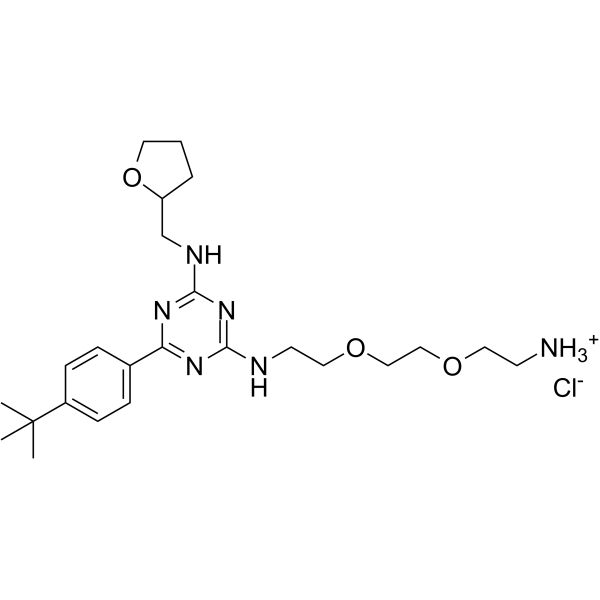
-
- HY-126154
-
|
|
Toll-like Receptor (TLR)
|
Inflammation/Immunology
|
|
L48H37 is an analog of Curcumin (HY-N0005) with improved chemical stability. L48H37 is a potent and specific myeloid differentiation protein 2 (MD2) inhibitor and inhibits the interaction and signaling transduction of LPS-TLR4/MD2. L48H37 is used for the research of sepsis or lung injury treatment .
|
-
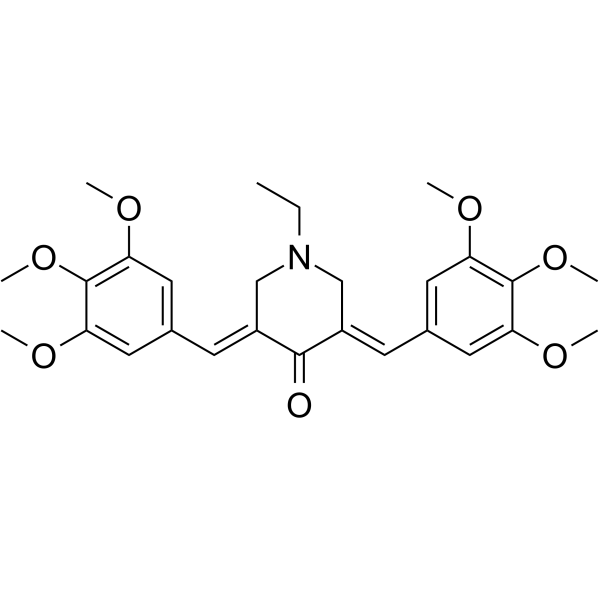
-
- HY-146066
-
|
|
nAChR
JAK
STAT
NO Synthase
|
Inflammation/Immunology
|
|
α7 nAchR-JAK2-STAT3 agonist 1 is a potent α7 nAchR-JAK2-STAT3 agonist, with an IC50 value of 0.32 μM for nitric oxide (NO). α7 nAchR-JAK2-STAT3 agonist 1 effectively suppresses the expression of iNOS, IL-1β, and IL-6 in murine RAW264.7 macrophages. α7 nAchR-JAK2-STAT3 agonist 1 can inhibit LPS-induced NO release, NF-κB activation and cytokine production. α7 nAchR-JAK2-STAT3 can be used for researching sepsis .
|
-
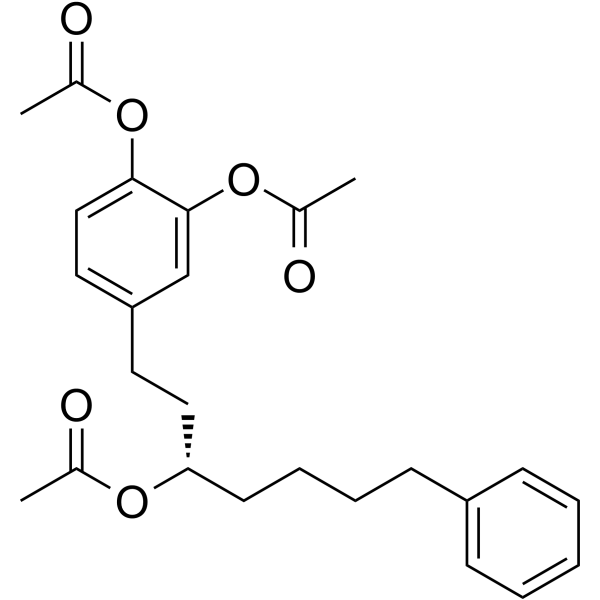
-
- HY-156519
-
|
|
NF-κB
|
Inflammation/Immunology
|
|
ALPK1-IN-3 is an inhibitor of ALPK1 extracted from patent WO2022063153A1 compound T007. ALPK1-IN-3 inhibits kidney proinflammatory gene expression and improves the survival rate of the animals in sepsis induced acute kidney injury animal model . ALPK1-IN-3 is a click chemistry reagent, it contains an Alkyne group and can undergo copper-catalyzed azide-alkyne cycloaddition (CuAAc) with molecules containing Azide groups.
|
-

-
- HY-143456
-
|
|
Others
|
Inflammation/Immunology
|
|
Anti-inflammatory agent 18 (compound 3b) shows NO inhibitory activity, with an IC50 of 15.94 μM. Anti-inflammatory agent 18 inhibits HMGB1-induced later inflammation. Anti-inflammatory agent 18 can be used for the research of later inflammation diseases such as coronavirus diseases (COVID-19) and sepsis, etc .
|
-
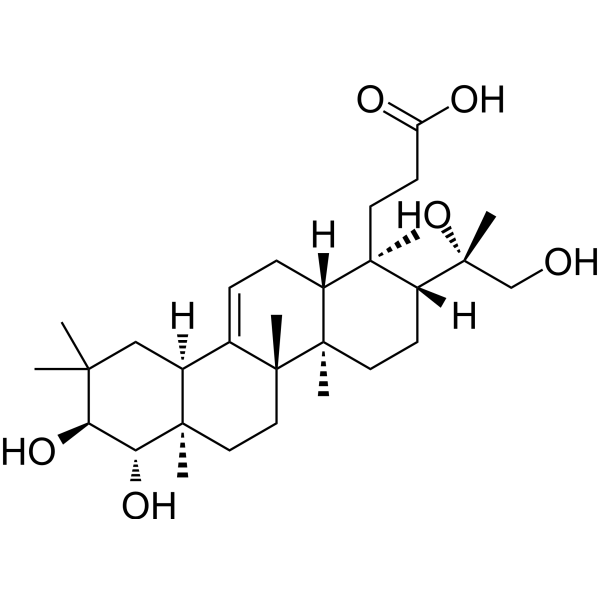
-
- HY-143457
-
|
|
Others
|
Inflammation/Immunology
|
|
Anti-inflammatory agent 19 (compound 2b) shows NO inhibitory activity, with an IC50 of 36.00 μM. Anti-inflammatory agent 19 inhibits HMGB1-induced later inflammation. Anti-inflammatory agent 19 can be used for the research of later inflammation diseases such as coronavirus diseases (COVID-19) and sepsis, etc .
|
-
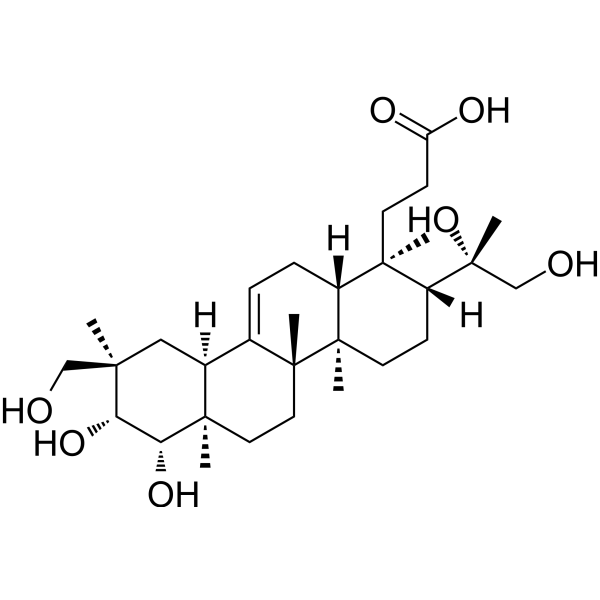
-
- HY-B1924
-
|
Desmethyl-vancomycin hydrochloride
|
Bacterial
Antibiotic
|
Infection
|
|
Norvancomycin hydrochloride is suitable for endocarditis, osteomyelitis, pneumonia, sepsis or soft tissue infections caused by Staphylococcus aureus (including methicillin-resistant strains and multi-drug-resistant strains).
|
-

-
- HY-P99309
-
|
BSYX-A 110; Anti-S. Epidermidis LTA Recombinant Antibody
|
Bacterial
|
Infection
|
|
Pagibaximab is a chimeric IgG1 antibody recognizing the surface component lipoteichoic acid of S. aureus and S. epidermidis. Pagibaximab can be used to prevent staphylococcal sepsis .
|
-

-
- HY-144220
-
-
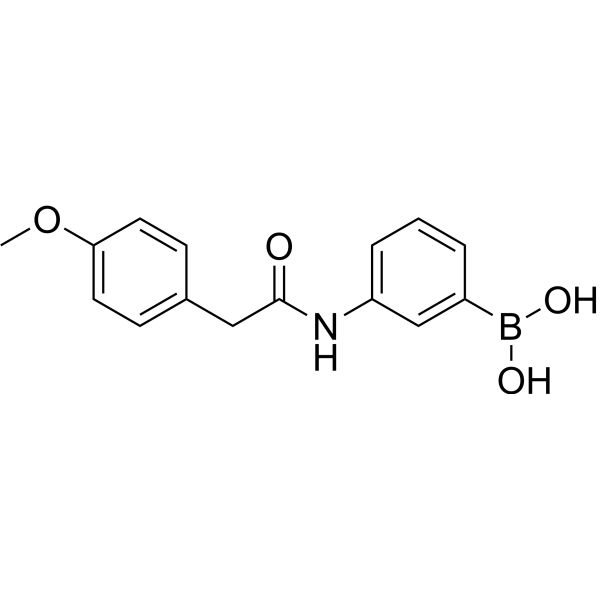
-
- HY-B0977
-
|
Dicloxacillin sodium salt monohydrate
|
Bacterial
Antibiotic
|
Infection
Inflammation/Immunology
|
|
Dicloxacillin Sodium hydrate (Dicloxacillin sodium salt monohydrate) is a narrow-spectrum β-Lactam antibiotic of the penicillin class, is used to treat infections caused by susceptible Gram-positive bacteria, active against beta-lactamase-producing organisms such as Staphylococcus aureus .
|
-
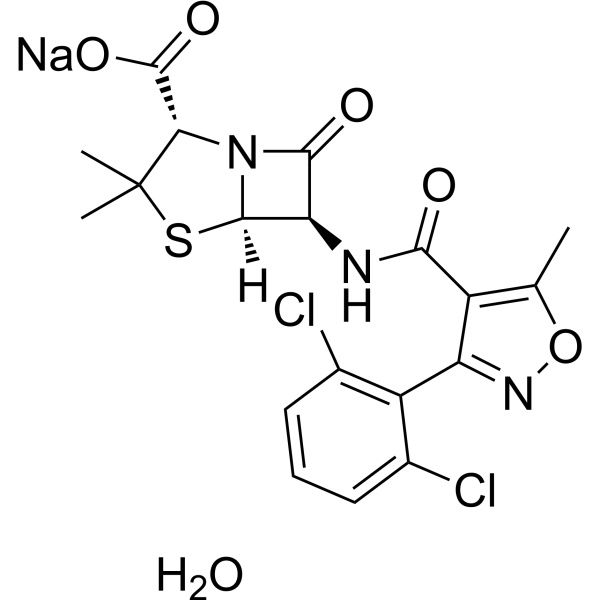
-
- HY-141616
-
-
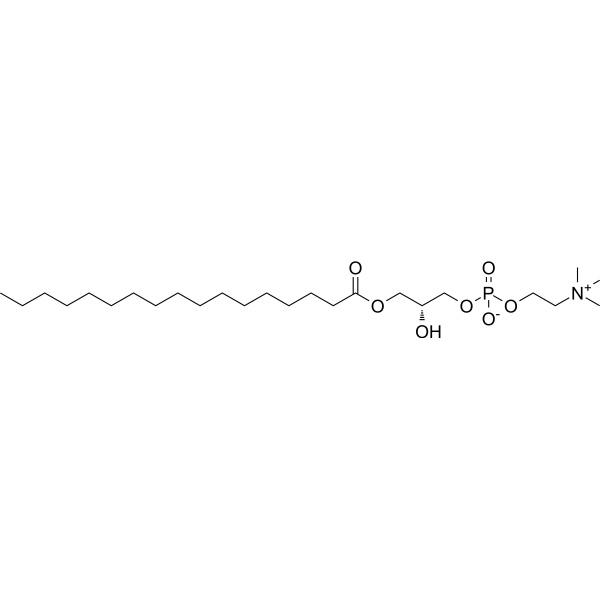
-
- HY-N2351
-
|
|
Others
|
Infection
Metabolic Disease
Inflammation/Immunology
|
|
Paeonoside is a bioactive compound identified in P. suffruticosa that promotes wound healing and migration in osteoblast differentiation. Paeonoside has also been reported to have some antidiabetic activity and may prevent sepsis-induced lethality .
|
-
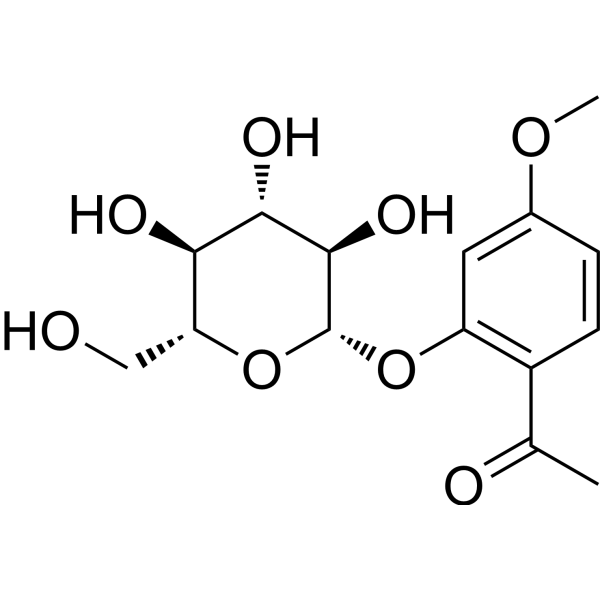
-
- HY-136066
-
|
TωMCA sodium
|
Others
|
Metabolic Disease
|
|
Tauro-ω-muricholic acid sodium (TωMCA sodium) is a bile acid released by the liver and an analog of tauro-α-muricholic acid. Tauro-ω-muricholic acid sodium is investigated as a potential marker in plasma for early-onset neonatal sepsis (EOS) and cholestasis studies
|
-

-
- HY-139414
-
|
|
Interleukin Related
p38 MAPK
ERK
Apoptosis
|
Inflammation/Immunology
|
|
Lysophosphatidylcholines is an orally active lysolipid and a component of oxidized low density lipoprotein (LDL). Lysophosphatidylcholines induces cell injury, the production of IL-1β and apoptosis. Lysophosphatidylcholines has a proactive effect on sepsis .
|
-

-
- HY-155250
-
|
|
Bacterial
|
Infection
|
|
Antibacterial agent 154 (compound 7) is a derivative of Fluoroqinolones and is an orally effective antibacterial agent. Antibacterial agent 154 inhibits Gram-positive and Gram-negative bacteria. Antibacterial agent 154 demonstrated in vivo efficacy in a mouse model of staphylococcal sepsis .
|
-
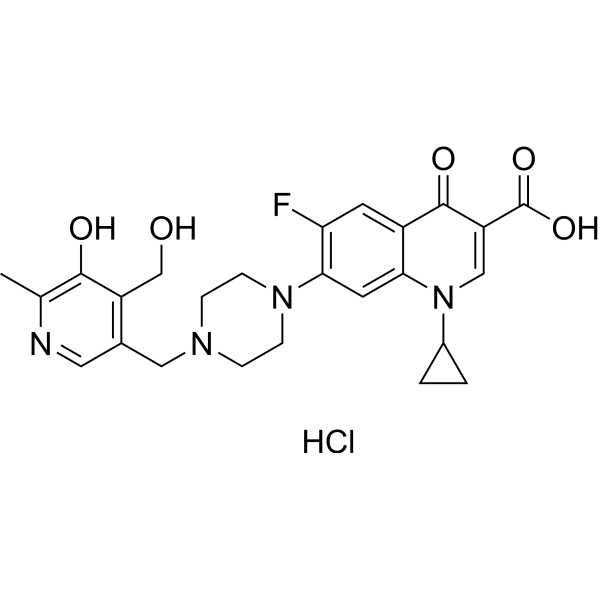
-
- HY-163409
-
|
|
β-catenin
|
Inflammation/Immunology
Cancer
|
|
CKG012 is an inhibitor for Wnt/βcatenin signaling pathway. CGK012 inhibits release of HMGB1 and transcription of β-catenin, exhibits attenuating activities against cecal ligation and puncture (CLP)-induced sepsis and multiple myeloma cancer .
|
-

-
- HY-126042
-
|
(±)-Lisophylline
|
Others
|
Metabolic Disease
Inflammation/Immunology
|
|
(±)-Lisofylline ((±)-Lisophylline) is the racemate of Lisofylline. Lisofylline inhibits the generation of phosphatidic acid and free fatty acids. Lisofylline also blocks the release of pro-inflammatory cytokines in oxidative tissue injury, in response to cancer chemotherapy and in experimental sepsis. Lisofylline can be used for Type 1 diabetes research .
|
-
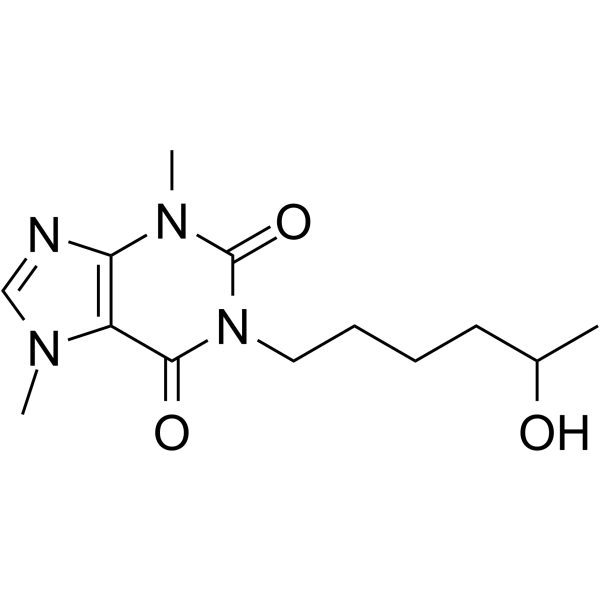
-
- HY-107329
-
|
|
Bacterial
Antibiotic
|
Infection
|
|
Cefathiamidine is a first-generation cephalosporin antibacterial agent and is used to treat infections caused by susceptible bacteria. Cefathiamidine exhibits a wide spectrum of antimicrobial activity against bacteria. Cefathiamidine is used for the treatment of respiratory, liver, five senses, urinary tract infections, endocarditis and sepsis .
|
-
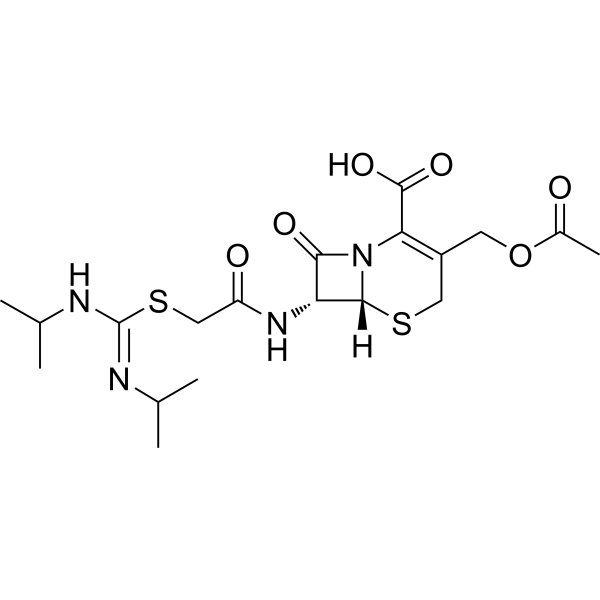
-
- HY-B0282
-
|
ACh chloride
|
nAChR
Calcium Channel
Endogenous Metabolite
|
Neurological Disease
Cancer
|
|
Acetylcholine chloride (ACh chloride), a neurotransmitter, is a potent cholinergic agonist. Acetylcholine chloride is a modulator of the activity of dopaminergic (DAergic) neurons through the stimulation of nicotinic acetylcholine receptors (nAChRs) . Acetylcholine chloride inhibits p53 mutant peptide aggregation in vitro .
|
-
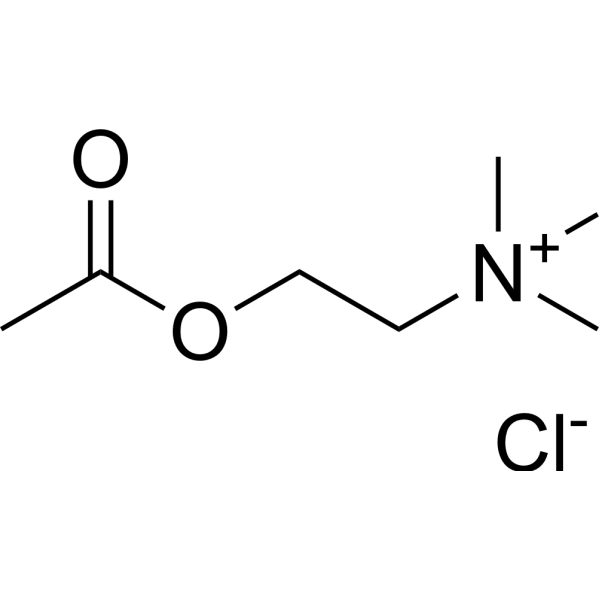
-
- HY-105239
-
|
FE 202158
|
Vasopressin Receptor
|
Cardiovascular Disease
|
|
Selepressin (FE 202158) is a selective vasopressin V1A receptor agonist. Selepressin is a potent vasopressor. Selepressin can be used in the research of septic shock .
|
-

- HY-105239A
-
|
FE 202158 acetate
|
Vasopressin Receptor
|
Cardiovascular Disease
|
|
Selepressin (FE 202158) acetate is a selective vasopressin V1A receptor agonist. Selepressin acetate is a potent vasopressin. Selepressin acetate can be used in the study of septic shock.
|
-
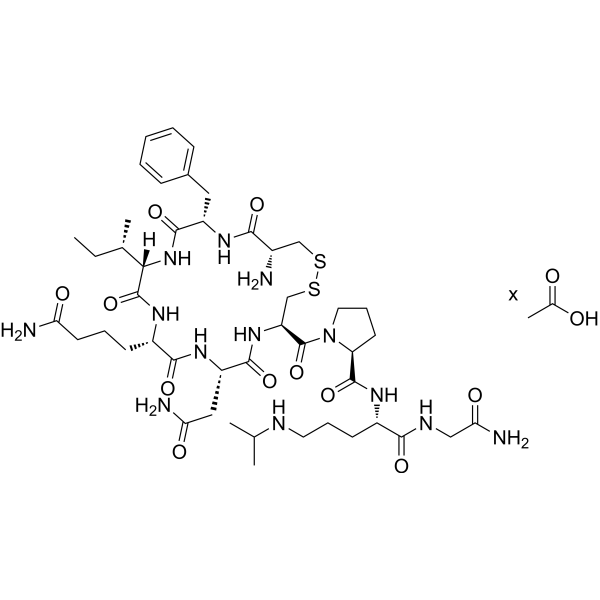
- HY-N12344
-
|
|
JNK
|
Inflammation/Immunology
|
|
n-Butyl α-D-fructofuranoside, isolated from the root barks of Ulmus davidiana var. japonica, enhances Nrf2 activity through activation of JNK and has antiinflammation activity .
|
-

- HY-A0248
-
|
|
Bacterial
Antibiotic
|
Infection
|
|
Polymyxin B Sulfate is a potent antibacterial agent and a relatively toxic antibiotic. Polymyxin B Sulfate also is a antiendotoxin agent. Polymyxin B Sulfate shows endotoxin-neutralizing properties can be used as adjunctive research in gram-negative sepsis. Polymyxin B Sulfate shows antibacterial activities in vitro and in vivo .
|
-
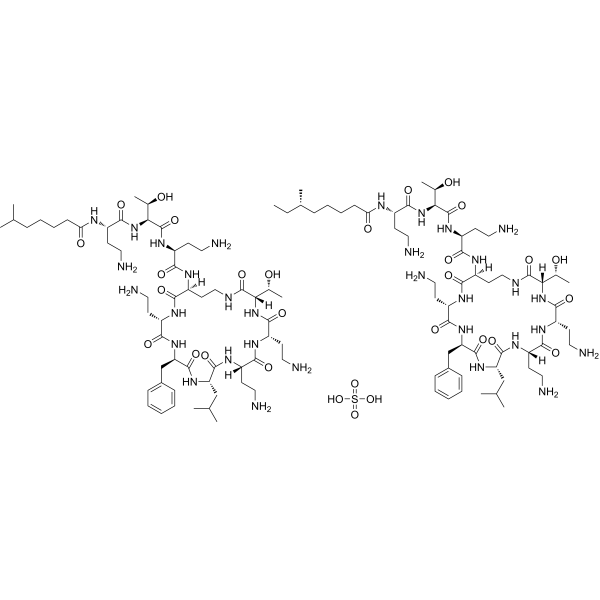
- HY-121636
-
|
RvD2
|
TRP Channel
|
Infection
Neurological Disease
Inflammation/Immunology
|
|
Resolvin D2 is a metabolite of docosahexaenoic acid (DHA), with anti-inflammatory, anti-infective activities. Resolvin D2 is a potent regulator of leukocytes and controls microbial sepsis. Resolvin D2 is a remarkably potent inhibitor of TRPV1 (IC50 = 0.1 nM) and TRPA1 (IC50 = 2 nM) in primary sensory neurons .
|
-

- HY-151537
-
|
|
Fluorescent Dye
|
Infection
Inflammation/Immunology
|
|
Gol-NTR is a Golgi-targetable probe with high selectivity and sensitivity. Gol-NTR is Nitroreductase (NTR)-activated and has visualization acute lung injury (ALI) and repair function. Gol-NTR has a low detection limit of 54.8 ng/mL. Gol-NTR can be used for the research for monitoring and assessing research response of sepsis-induced ALI .
|
-
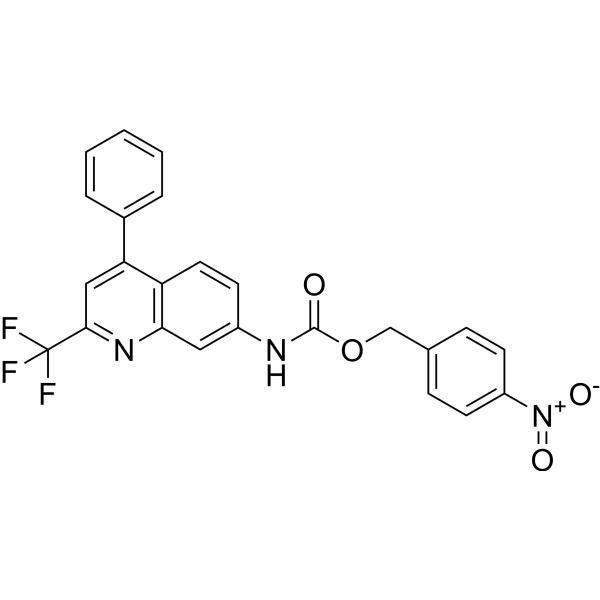
- HY-103017A
-
|
|
IRAK
|
Infection
Inflammation/Immunology
Cancer
|
|
JH-X-119-01 is a potent and selective interleukin-1 receptor-associated kinases 1 (IRAK1) inhibitor. JH-X-119-01 ameliorates LPS-induced sepsis in mice . JH-X-119-01 inhibits IRAK1 biochemically with an apparent IC50 of 9 nM while exhibiting no inhibition of IRAK4 at concentrations up to 10 μM .
|
-
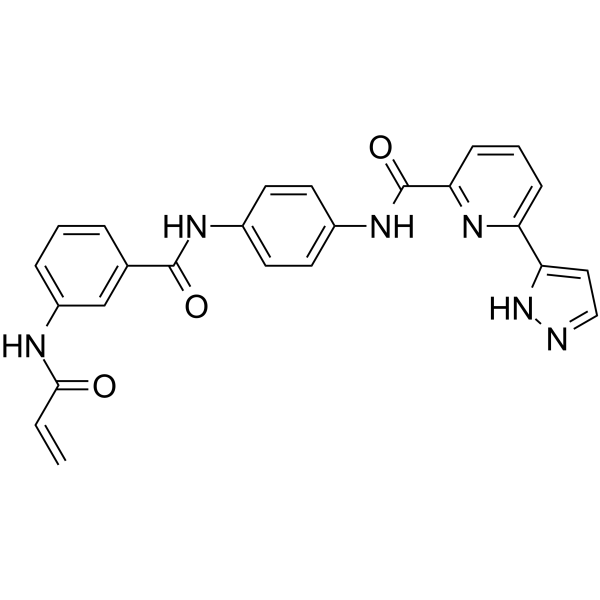
- HY-149580
-
|
|
NF-κB
|
Inflammation/Immunology
|
|
NF-κB-IN-12 (compound 3h) is a potent NF-κB inhibitor, with an IC50 of 1.02 μM. NF-κB-IN-12 can be used for acute lung injury research .
|
-
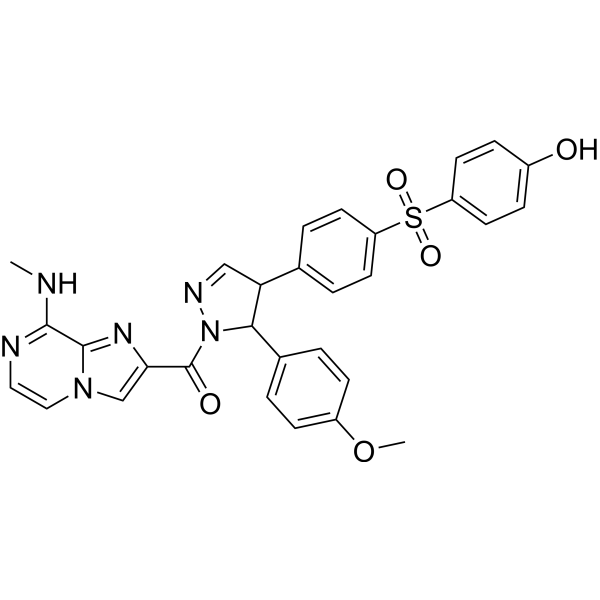
- HY-149426
-
|
|
Sirtuin
|
Inflammation/Immunology
|
|
SIRT5 inhibitor 7 (compound 58) is a substrate-competitive and selective SIRT5 inhibitor with anti-inflammatory activity. SIRT5 inhibitor 7 has renal protective effects and regulates protein succinylation and the release of pro-inflammatory cytokines. SIRT5 inhibitor 7 has in vivo activity in AKI mouse models of lipopolysaccharide (LPS) and cecal ligation/perforation (CLP)-induced sepsis-related acute kidney injury .
|
-
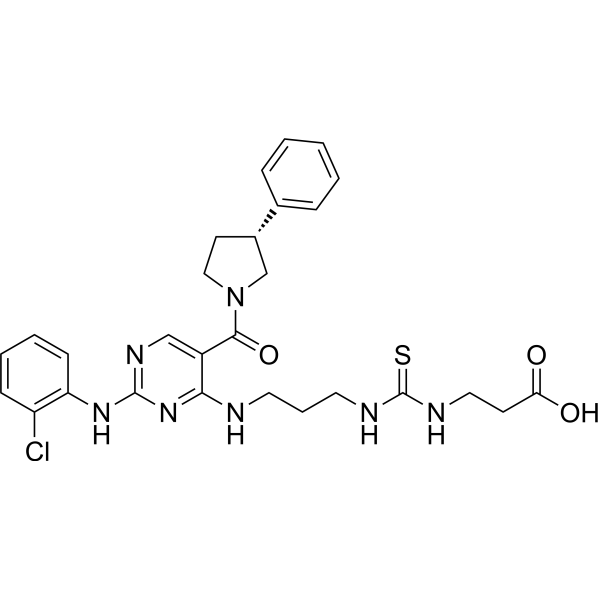
- HY-121636S
-
|
RvD2-d5
|
TRP Channel
|
Infection
Neurological Disease
Inflammation/Immunology
|
|
Resolvin D2-d5 is the deuterium labeled Resolvin D2. Resolvin D2 is a metabolite of docosahexaenoic acid (DHA), with anti-inflammatory, anti-infective activities. Resolvin D2 is a potent regulator of leukocytes and controls microbial sepsis. Resolvin D2 is a remarkably potent inhibitor of TRPV1 (IC50 = 0.1 nM) and TRPA1 (IC50 = 2 nM) in primary sensory neurons[1][2][3].
|
-
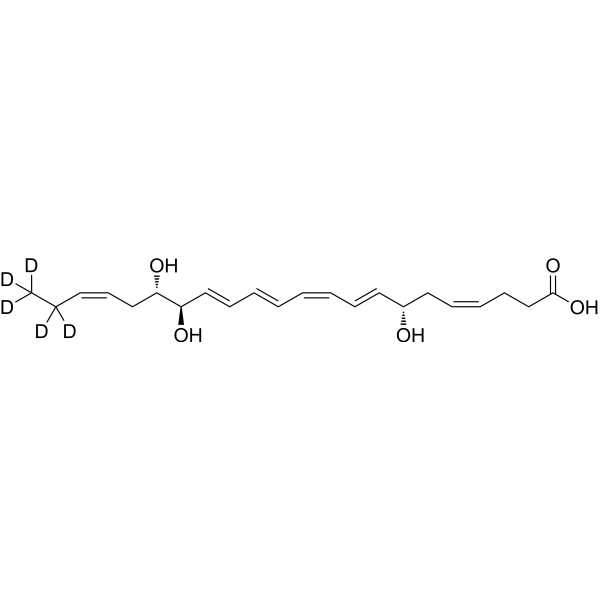
- HY-146974
-
|
|
Phosphodiesterase (PDE)
|
Inflammation/Immunology
|
|
PDE4-IN-9 (Compound 5j) is a potent inhibitor of PDE4. PDE4-IN-9 exhibits lower IC50 value (1.4 μM) against PDE4 than parent rolipram (2.0 μM) in in vitro enzyme assay. PDE4-IN-9 also displays good in vivo activity in animal models of asthma/COPD and sepsis induced by LPS .
|
-
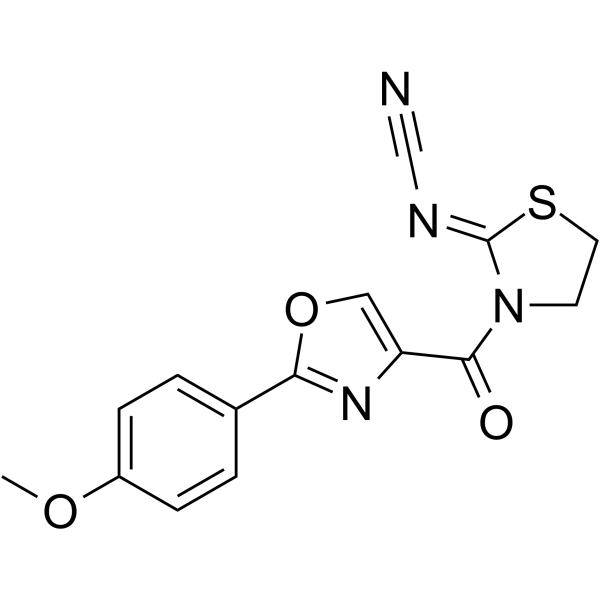
- HY-155751
-
-
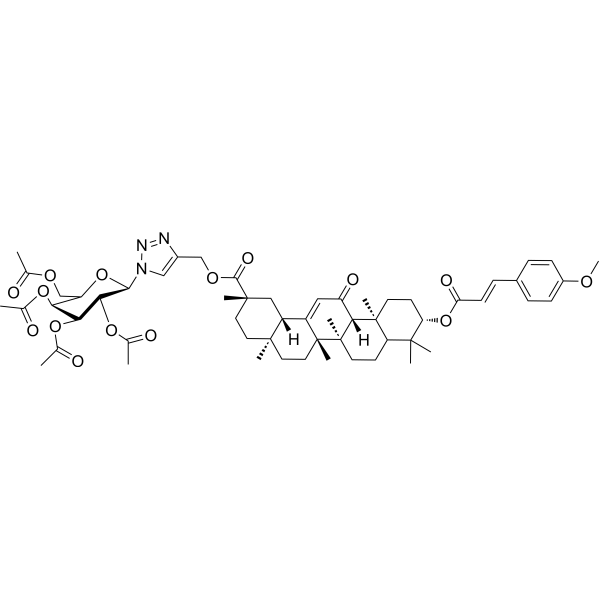
- HY-P4846
-
|
|
CXCR
|
Inflammation/Immunology
|
|
Ac-Pro-Gly-Pro-OH is an endogenous degradation product of extracellular collagen and can be used as CXCR2 agonist. Ac-Pro-Gly-Pro-OH elicits bactericidal activity and inhibits lung inflammation, reducing immune cell apoptosis. Ac-Pro-Gly-Pro-OH enhances the production of type 1 cytokines (IFN-γ and IL-12) but inhibits the production of proinflammatory cytokines. Ac-Pro-Gly-Pro-OH has the potential for the research of sepsis .
|
-
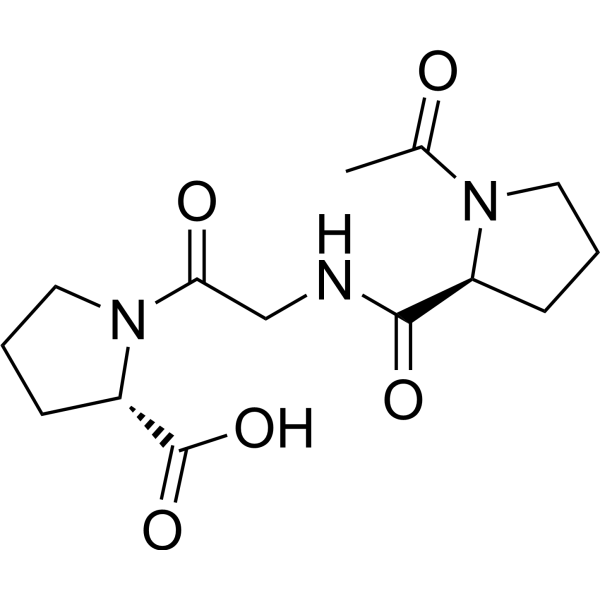
- HY-100574A
-
|
|
|
|
|
Cl-amidine hydrochloride is an orally active peptidylarginine deminase (PAD) inhibitor, with IC50 values of 0.8 μM, 6.2 μM and 5.9 μM for PAD1, PAD3, and PAD4, respectively. Cl-amidine hydrochloride induces apoptosis in cancer cells. Cl-amidine hydrochloride induces microRNA (miR)-16 (miRNA-16, microRNA-16) expression and causes cell cycle arrest. Cl-Amidine hydrochloride prevents histone 3 citrullination and neutrophil extracellular trap formation, and improves survival in a murine sepsis model .
|
-
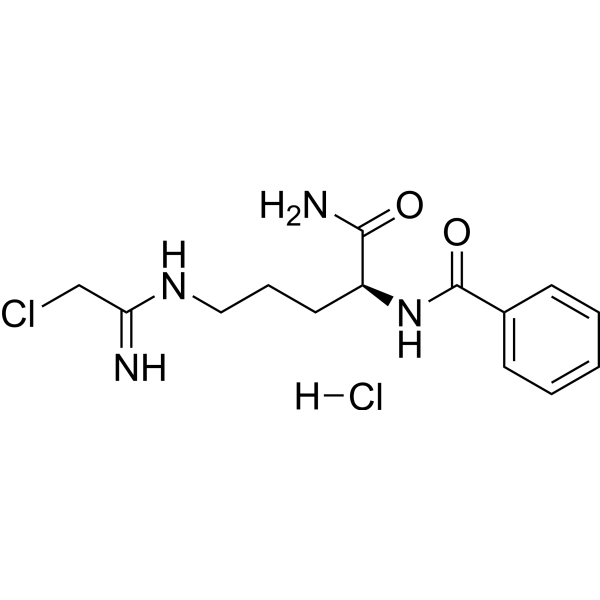
- HY-100574
-
|
|
|
|
|
Cl-amidine is an orally active peptidylarginine deminase (PAD) inhibitor, with IC50 values of 0.8 μM, 6.2 μM and 5.9 μM for PAD1, PAD3, and PAD4, respectively. Cl-amidine induces apoptosis in cancer cells. Cl-amidine induces microRNA (miR)-16 (miRNA-16, microRNA-16) expression and causes cell cycle arrest. Cl-Amidine prevents histone 3 citrullination and neutrophil extracellular trap formation, and improves survival in a murine sepsis model .
|
-
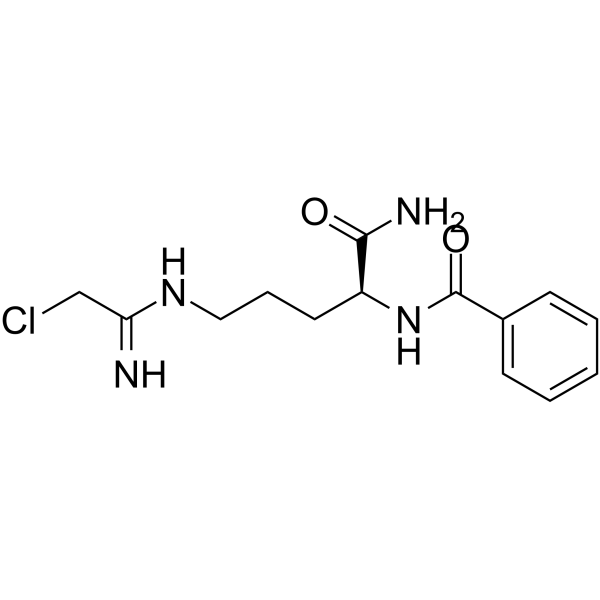
- HY-N0408
-
|
|
NF-κB
Reactive Oxygen Species
Apoptosis
Influenza Virus
|
Infection
Neurological Disease
Inflammation/Immunology
Cancer
|
|
Picroside II, an iridoid compound extracted from Picrorhiza, exhibits anti-inflammatory and anti-apoptotic activities.
picroside II alleviates the inflammatory response in sepsis and enhances immune function by inhibiting the activation of NLRP3 inflammasome and NF-κB pathways .
Picroside II is an antioxidant, exhibits a significant neuroprotective effect through reducing ROS production and protects the blood-brain barrier (BBB) after cerebral ischemia-reperfusion (CI/R) injury. Picroside II has antioxidant, anti-inflammatory, immune regulatory, anti-virus and other pharmacological activities .
|
-
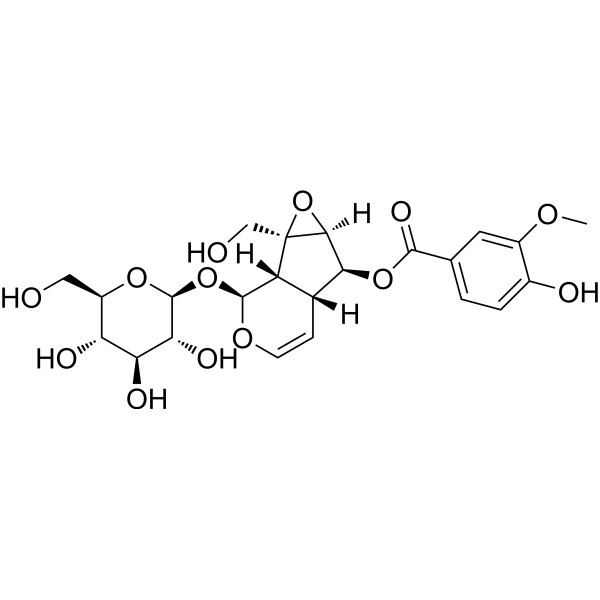
- HY-155194
-
|
|
Others
|
Inflammation/Immunology
|
|
P2X7 receptor antagonist-4 (Compound 14a) is a P2X7R antagonist. The P2X7 receptor antagonist-4 values of P2X7R IC50 in human and mouse are 64.7 and 10.1 nM, respectively. P2X7 receptor antagonist-4 can inhibit the activation of NLRP3 inflammasome, thereby inhibiting the expression of caspase-1, gasdermin D, IL-1β and IL-18 in the damaged kidney of sepsis mice .
|
-
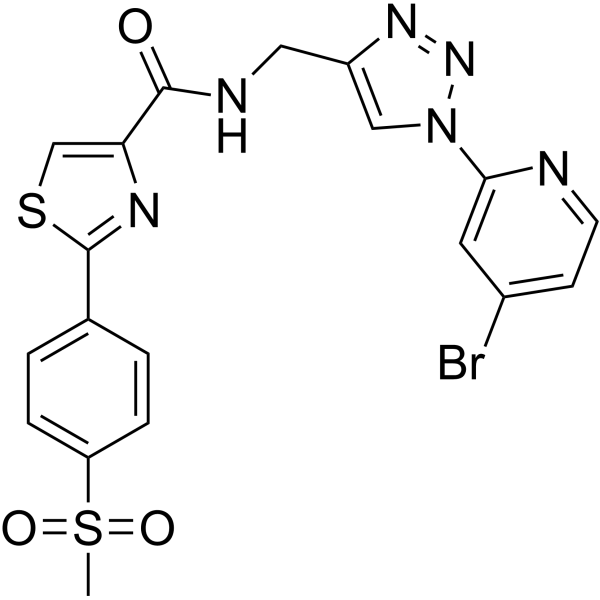
- HY-12118
-
-
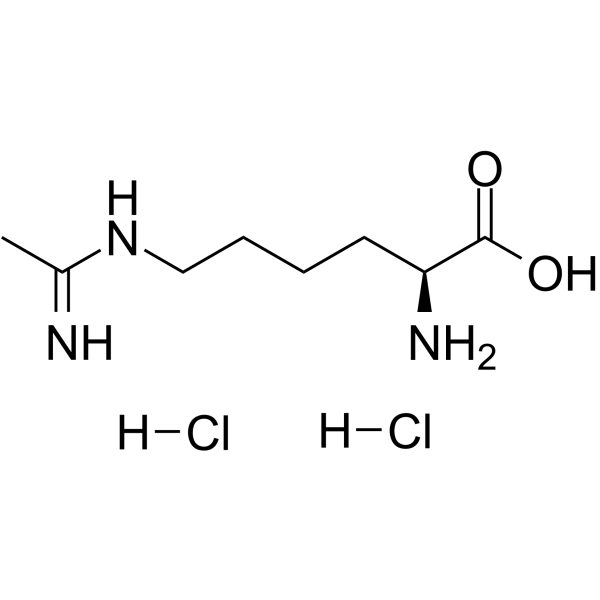
- HY-P3496
-
|
|
Pyroptosis
|
Inflammation/Immunology
|
|
Pep19-2.5 is an synthetic and antitoxin peptide, blocks the intracellular endotoxin signaling cascade. Pep19-2.5 inhibits signaling of lipopeptides (LP) and lipopolysaccharides (LPS) mediated by transmembrane and cytosolic pattern recognition receptors (PRRs). The signaling cascades lead to inflammation and cell pyroptosis .
|
-

- HY-105088
-
|
MSI 78 free base
|
Bacterial
|
Infection
|
|
Pexiganan (MSI 78 free base) is a synthetic analog of magainin 2. Pexiganan is a potent and orally active broad-spectrum antimicrobial peptide. Pexiganan can be used in the research of infections, such as diabetic foot ulcer infections .
|
-

- HY-N7741
-
|
Dehydrozaluzanin C-derivative
|
Others
|
Infection
Inflammation/Immunology
|
|
Isozaluzanin C (Dehydrozaluzanin c-derivative) is an anti-inflammatory agent that can be isolated from Saussurea lappa and has immunomodulatory effects. Isozaluzanin C improves tissue damage (lung, kidney, and liver) and excessive inflammation in mice induced by LPS (HY-D1056) or CRKP infection. Isozaluzanin C can be used in the study of bacterial infections and sepsi .
|
-
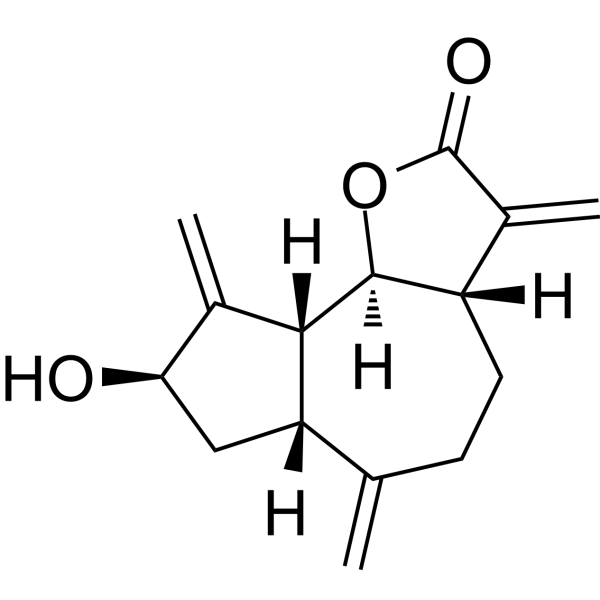
- HY-15208
-
|
HMR 1098
|
Potassium Channel
|
Neurological Disease
|
|
Clamikalant sodium (HMR 1098) is an ATP-sensitive potassium (KATP) channel blocker. Clamikalant sodium can be used for the research of arrhythmia .
|
-
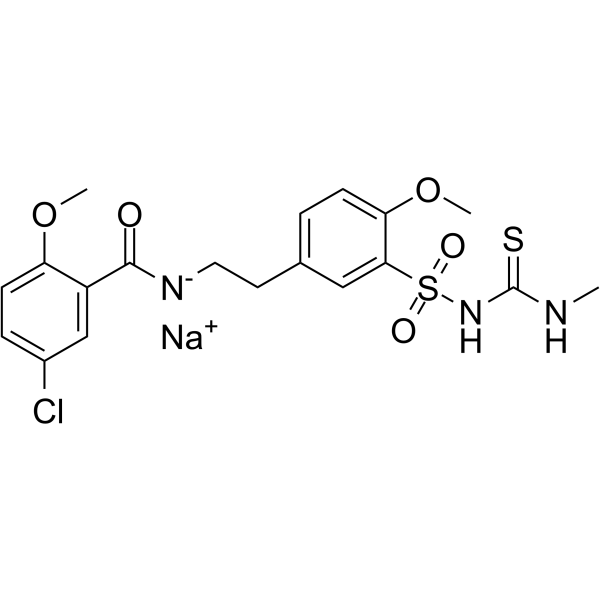
- HY-B1075
-
|
MK-0955 calcium
|
Bacterial
Antibiotic
|
Infection
Cancer
|
|
Fosfomycin (MK-0955) calcium is a blood-brain barrier penetrating, broad-spectrum antibiotic by irreversibly inhibiting an early stage in cell wall synthesis. Fosfomycin calcium shows both in vivo and in vitro activity against a wide range of bacteria, including multidrug-resistant (MDR), extensively drug-resistant (XDR), and pan-drug-resistant (PDR) bacteria .
|
-

- HY-B0609
-
|
MK-0955 tromethamine
|
Bacterial
Antibiotic
|
Infection
Cancer
|
|
Fosfomycin (MK-0955) tromethamine is a blood-brain barrier penetrating, broad-spectrum antibiotic by irreversibly inhibiting an early stage in cell wall synthesis. Fosfomycin tromethamine shows both in vivo and in vitro activity against a wide range of bacteria, including multidrug-resistant (MDR), extensively drug-resistant (XDR), and pan-drug-resistant (PDR) bacteria .
|
-
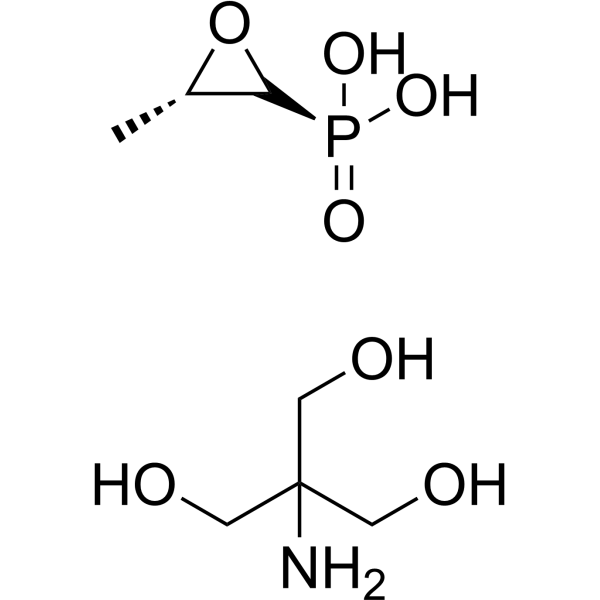
- HY-W016420
-
|
MK-0955 sodium
|
Bacterial
Antibiotic
|
Infection
Cancer
|
|
Fosfomycin (MK-0955) sodium is a blood-brain barrier penetrating, broad-spectrum antibiotic by irreversibly inhibiting an early stage in cell wall synthesis. Fosfomycin sodium shows both in vivo and in vitro activity against a wide range of bacteria, including multidrug-resistant (MDR), extensively drug-resistant (XDR), and pan-drug-resistant (PDR) bacteria .
|
-

- HY-B1075A
-
|
MK-0955
|
Bacterial
Antibiotic
|
Infection
|
|
Fosfomycin (MK-0955) is a broad-spectrum antibiotic. Fosfomycin can cross blood-brain barrier penetrating, and irreversibly inhibits an early stage in cell wall synthesis. Fosfomycin shows anti-bacteria activity for a range of bacteria, including multidrug-resistant (MDR), extensively drug-resistant (XDR), and pan-drug-resistant (PDR) bacteria .
|
-
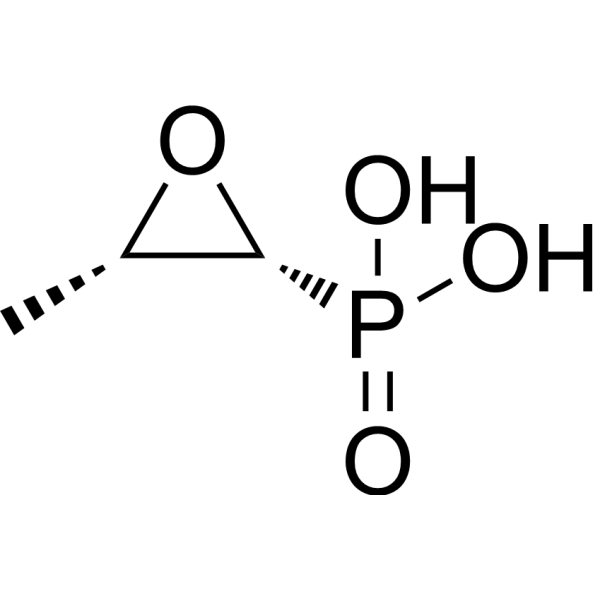
- HY-160637
-
-
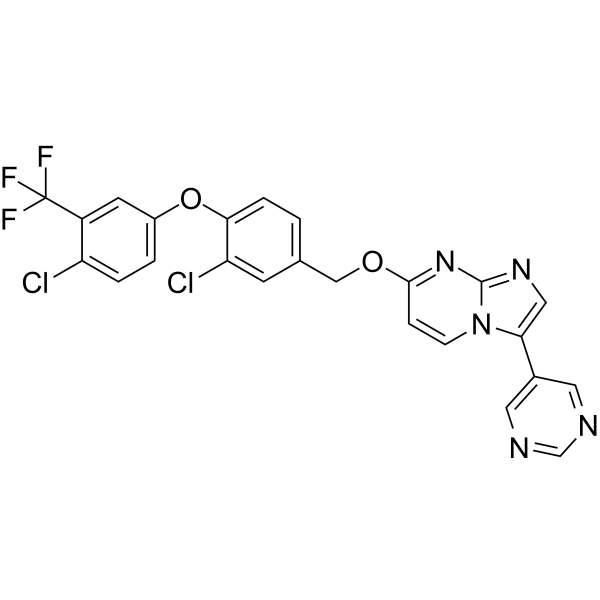
| Cat. No. |
Product Name |
Type |
-
- HY-151537
-
|
|
Fluorescent Dyes/Probes
|
|
Gol-NTR is a Golgi-targetable probe with high selectivity and sensitivity. Gol-NTR is Nitroreductase (NTR)-activated and has visualization acute lung injury (ALI) and repair function. Gol-NTR has a low detection limit of 54.8 ng/mL. Gol-NTR can be used for the research for monitoring and assessing research response of sepsis-induced ALI .
|
| Cat. No. |
Product Name |
Type |
-
- HY-139414
-
|
|
Biochemical Assay Reagents
|
|
Lysophosphatidylcholines is an orally active lysolipid and a component of oxidized low density lipoprotein (LDL). Lysophosphatidylcholines induces cell injury, the production of IL-1β and apoptosis. Lysophosphatidylcholines has a proactive effect on sepsis .
|
| Cat. No. |
Product Name |
Target |
Research Area |
-
- HY-P5949
-
|
|
Bacterial
|
Infection
|
|
AMPR-22 is an antimicrobial peptide. AMPR-22 can bind to the bacterial membrane and induces membrane permeabilization. AMPR-22 is effective against murine model of sepsis induced by MDR strains
|
-
- HY-P10208A
-
-
- HY-P10208
-
|
|
Toll-like Receptor (TLR)
|
Infection
|
|
PKH is a TLR4 antagonist. PKH is a novel tripeptide and can be isolated from Akkermansia muciniphila. RKH reduces sepsis-induced inflammatory cell activation and proinflammatory factor overproduction .
|
-
- HY-P3031
-
|
MAPK1
|
p38 MAPK
NF-κB
|
Inflammation/Immunology
|
|
Mitogen-activated protein kinase 1 (MAPK1) can activate the downstream p38/NF-κB pathway. Mitogen-activated protein kinase 1 can regulate cellular processes in various sepsis-associated diseases. MAPK-catalyzed phosphorylation of substrate proteins functions as a switch to turn on or off the activity of the substrate protein .
|
-
- HY-P2682
-
|
|
MMP
|
Metabolic Disease
|
|
MMP-8/MMP-26 Fluorogenic substrate (DNP-Pro-Leu-Ala-Tyr-Trp-Ala-Arg) is a matrix metalloproteinase-8 (MMP-8) fluorogenic substrate. MMP-8/MMP-26 Fluorogenic substrate can be used for the research of atherosclerosis, pulmonary fibrosis, and sepsis .
|
-
- HY-P2458
-
|
|
Bacterial
|
Infection
|
|
CAP18 (rabbit) is a 37 amino acids antimicrobial peptide originally isolated from rabbit granulocytes. CAP18 (rabbit) has broad antimicrobial activity against both Gram-positive (IC50, 130-200 nM) and Gram-negative (IC50, 20-100 nM) bacteria. CAP18 (rabbit) has the potential for bacterial sepsis research .
|
-
- HY-P3612
-
|
|
CXCR
|
Inflammation/Immunology
|
|
CTCE-0214 is a chemokine CXC receptor 4 (CXCR4) agonist, SDF-1α (stromal cell-derived factor-1α) peptide analog. CTCE-0214 shows anti-inflammatory activity, and can be used in inflammation sepsis and systemic inflammatory syndromes research .
|
-
- HY-106279
-
|
|
Peptides
|
Inflammation/Immunology
|
|
EA-230 is a synthetic oligopeptide originally derived from beta-human chorionic gonadotropin (beta-hCG) lysates. EA-230 has anti-inflammatory effects and can be used for the research of sepsis .
|
-
- HY-105239
-
|
FE 202158
|
Vasopressin Receptor
|
Cardiovascular Disease
|
|
Selepressin (FE 202158) is a selective vasopressin V1A receptor agonist. Selepressin is a potent vasopressor. Selepressin can be used in the research of septic shock .
|
-
- HY-105239A
-
|
FE 202158 acetate
|
Vasopressin Receptor
|
Cardiovascular Disease
|
|
Selepressin (FE 202158) acetate is a selective vasopressin V1A receptor agonist. Selepressin acetate is a potent vasopressin. Selepressin acetate can be used in the study of septic shock.
|
-
- HY-A0248
-
|
|
Bacterial
Antibiotic
|
Infection
|
|
Polymyxin B Sulfate is a potent antibacterial agent and a relatively toxic antibiotic. Polymyxin B Sulfate also is a antiendotoxin agent. Polymyxin B Sulfate shows endotoxin-neutralizing properties can be used as adjunctive research in gram-negative sepsis. Polymyxin B Sulfate shows antibacterial activities in vitro and in vivo .
|
-
- HY-P4846
-
|
|
CXCR
|
Inflammation/Immunology
|
|
Ac-Pro-Gly-Pro-OH is an endogenous degradation product of extracellular collagen and can be used as CXCR2 agonist. Ac-Pro-Gly-Pro-OH elicits bactericidal activity and inhibits lung inflammation, reducing immune cell apoptosis. Ac-Pro-Gly-Pro-OH enhances the production of type 1 cytokines (IFN-γ and IL-12) but inhibits the production of proinflammatory cytokines. Ac-Pro-Gly-Pro-OH has the potential for the research of sepsis .
|
-
- HY-P3496
-
|
|
Pyroptosis
|
Inflammation/Immunology
|
|
Pep19-2.5 is an synthetic and antitoxin peptide, blocks the intracellular endotoxin signaling cascade. Pep19-2.5 inhibits signaling of lipopeptides (LP) and lipopolysaccharides (LPS) mediated by transmembrane and cytosolic pattern recognition receptors (PRRs). The signaling cascades lead to inflammation and cell pyroptosis .
|
-
- HY-105088
-
|
MSI 78 free base
|
Bacterial
|
Infection
|
|
Pexiganan (MSI 78 free base) is a synthetic analog of magainin 2. Pexiganan is a potent and orally active broad-spectrum antimicrobial peptide. Pexiganan can be used in the research of infections, such as diabetic foot ulcer infections .
|
| Cat. No. |
Product Name |
Target |
Research Area |
-
- HY-P99425
-
-
- HY-P99520
-
|
CaCP-29, IFX-1
|
Complement System
SARS-CoV
|
Infection
Inflammation/Immunology
|
|
Vilobelimab (CaCP-29, IFX-1) is a monoclonal anti-C5a antibody to the allergen C5a, a pro-inflammatory complement division product that plays a central role in mediating organ dysfunction. Vilobelimab acts as a C5a inhibitor, inhibiting neutrophil activation, chemotaxis, and reducing inflammatory signalling, and may be used in studies related to sepsis, COVID-19, etc .
|
-
- HY-P99309
-
|
BSYX-A 110; Anti-S. Epidermidis LTA Recombinant Antibody
|
Bacterial
|
Infection
|
|
Pagibaximab is a chimeric IgG1 antibody recognizing the surface component lipoteichoic acid of S. aureus and S. epidermidis. Pagibaximab can be used to prevent staphylococcal sepsis .
|
-
- HY-P99753
-
|
BAYX1351
|
TNF Receptor
|
Infection
|
|
Nerelimomab (BAYX1351) is an anti-TNF-α antibody. Nerelimomab can be used for research of sepsis .
|
| Cat. No. |
Product Name |
Category |
Target |
Chemical Structure |
| Cat. No. |
Product Name |
Chemical Structure |
-
- HY-121636S
-
|
|
|
Resolvin D2-d5 is the deuterium labeled Resolvin D2. Resolvin D2 is a metabolite of docosahexaenoic acid (DHA), with anti-inflammatory, anti-infective activities. Resolvin D2 is a potent regulator of leukocytes and controls microbial sepsis. Resolvin D2 is a remarkably potent inhibitor of TRPV1 (IC50 = 0.1 nM) and TRPA1 (IC50 = 2 nM) in primary sensory neurons[1][2][3].
|
-

| Cat. No. |
Product Name |
|
Classification |
-
- HY-156519
-
|
|
|
Alkynes
|
|
ALPK1-IN-3 is an inhibitor of ALPK1 extracted from patent WO2022063153A1 compound T007. ALPK1-IN-3 inhibits kidney proinflammatory gene expression and improves the survival rate of the animals in sepsis induced acute kidney injury animal model . ALPK1-IN-3 is a click chemistry reagent, it contains an Alkyne group and can undergo copper-catalyzed azide-alkyne cycloaddition (CuAAc) with molecules containing Azide groups.
|
Your information is safe with us. * Required Fields.
Inquiry Information
- Product Name:
- Cat. No.:
- Quantity:
- MCE Japan Authorized Agent:




















































































